Patronenlagerlehren - Einführung
Patronenlagerlehren werden eingesetzt, um die Maßhaltigkeit des Patronenlagers bei der Herstellung von Waffen bzw. Läufen, bei Nach- oder Änderungsarbeiten sowie beim amtlichen Beschuss zu prüfen. Grundlage für die Lehrenherstellung sind die Maßtafeln des BWaffG, die C.I.P.-Datenblätter sowie Maße nach den Veröffentlichungen der SAAMI oder nach Kundenangaben.
Die Fertigung erfolgt auf modernen CNC-Werkzeugmaschinen unter zusätzlicher Beachtung der für die Lehrenherstellung veröffentlichten Vorgaben deutscher und europäischer Normen. Die Lehren für die Prüfung des Verschlussabstandes werden als Doppellehre min/max (go/no-go) hergestellt und angeboten. Die Endkontrolle der Lehren wird mit einer computergesteuerten optischen Koordinatenmessanlage durchgeführt, die auch für Lohnvermessungen von Kundenlehren zur Verfügung steht.
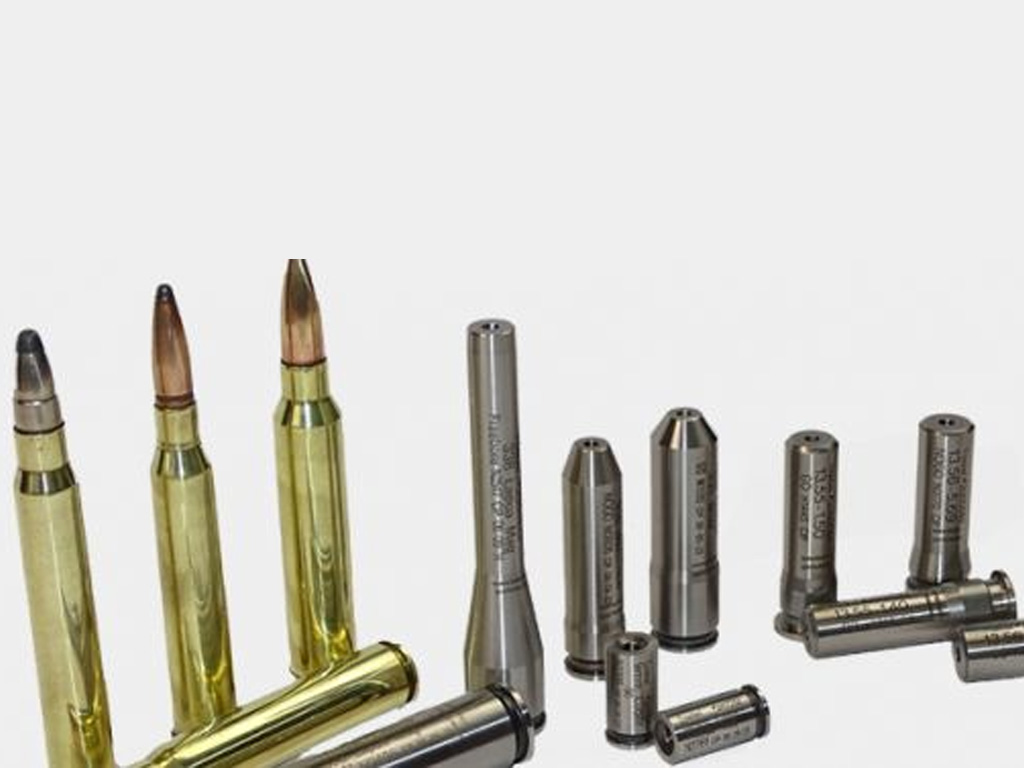
Maßliche Grundlagen für Patronenlagerlehren
Die Firma Triebel Waffenwerkzeuge ist seit vielen Jahrzenten kompetenter Ansprechpartner, wenn es um Patronenlagerlehren und deren technische Ausführung geht.
Grundsätzlich maßgebend sind die Vorgaben der ständigen internationalen Kommission für die Prüfung von Handfeuerwaffen, kurz C.I.P.
Leider ist bereits seit vielen Jahren auch bekannt, dass die von der C.I.P veröffentlichten Daten häufig fehlerhaft sind.
Aufgrund der komplexen und behäbigen Strukturen der C.I.P. ist jedoch eine zuverlässige Korrektur solcher Fehler in angemessener Zeit bisher selten möglich gewesen.
Als Partner von Industrie und Handwerk, mit entsprechender Kompetenz im Bereich Patronen- und Lagermaße, hat die Firma Triebel Waffenwerkzeuge in der Vergangenheit stets auf solche Fehler auf den offiziellen Wegen hingewiesen und zum Wohle der Branche angeboten, bei der Korrektur unterstützend tätig zu sein. Eine strukturelle Lösung der organisatorischen Grundprobleme der C.I.P., mit dem Ziel der Industrie verlässliche und brauchbare Daten zur Verfügung zu stellen, blieb bis heute jedoch aus.
Da unsere Kunden aber dringend auf eine exakte und praxistaugliche Ausführung von Patronenlagerlehren angewiesen sind, werden bei Triebel Waffenwerkzeuge die ursprünglichen Kaliberdaten der C.I.P. grundsätzlich umfangreich geprüft, mathematisch bereinigt und wenn nötig entsprechend korrigiert sowie die Maße um die für eine professionelle Lehrenfertigung nötige Anzahl an Nachkommastellen erweitert.
Diese aufwändige Arbeit ist die Basis für eine hauseigene Kaliber-Datenbank, die in Qualität und Umfang einmalig auf der Welt sein dürfte.
Logische Folge der Datenkorrekturen ist, dass gewisse Sollmaße von einzelnen Triebel-Lehren bewusst von den C.I.P. Vorgaben abweichen. Dies ergibt sich entsprechend durch die Einhaltung der exakt berechneten Maße nach der Datenkorrektur.
Im Sinne der Rückverfolgung der Daten werden ab Anfang 2023 davon betroffene Lehren mit dem Status „CIP+“ per Lasergravur und im zugehörigen Messprotokoll markiert. CIP+ bedeutet dabei, dass die sogenannten Basismaße der C.I.P Maßblätter eingehalten werden, jedoch die davon abgeleiteten Maße abweichen können.
Für eine professionelle Prüfmittelverwaltung und maßliche Kontrolle von Patronenlagerlehren ist es daher geboten, stets die Sollwerte aus dem Messprotokoll der Werksprüfung zu übernehmen. Dadurch werden Missverständnisse vermieden und sichergestellt, dass die entsprechende Lehre für die gedachte Prüfungsanwendung geeignet ist.
Im Einzelfall erhalten Sie auf Wunsch zu einem spezifischen Maß Auskunft per Email. Kontaktieren Sie uns dazu gerne über info@triebel-guntools.de, möglichst unter Angabe der Artikel- und Seriennummern der jeweiligen Lehren.
Lehren für Büchsenpatronenlager
Schulterlehren für Büchsenpatronenlager
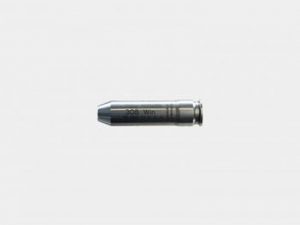 Diese Lehre prüft die Minimaltiefe L1 und L2 und damit die Lage der Schulter. Bei korrekter Lagertiefe muss sich bei eingeführter minimaler Schulterlehre der Verschluss der Waffe schließen lassen. Die Lage der Schulter entspricht den Minimalmaßen. Wenn eine Patrone mit Schulter weder Rand noch Gürtel hat, ist die Schulterlehre die Verschlussabstandslehre.
Diese Lehre prüft die Minimaltiefe L1 und L2 und damit die Lage der Schulter. Bei korrekter Lagertiefe muss sich bei eingeführter minimaler Schulterlehre der Verschluss der Waffe schließen lassen. Die Lage der Schulter entspricht den Minimalmaßen. Wenn eine Patrone mit Schulter weder Rand noch Gürtel hat, ist die Schulterlehre die Verschlussabstandslehre.
Die Lehre wird in Minimalausführung und Maximalausführung gefertigt. Sie werden immer paarweise verwendet. Die Maße sind für Waffen mit Zylinderverschluss vorgesehen. Für Selbstladewaffen und für Kipplaufwaffen gibt es teilweise abweichende Maße. Optional sind Lehrensätze mit Abstufung von z.B. 0,02mm erhältlich, um den Verschlussabstand genau feststellen zu können.
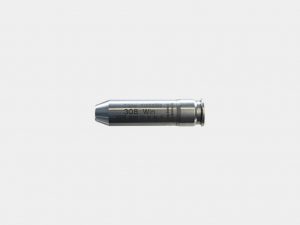 Diese Lehre prüft die Maximaltiefe L1 und L2 und damit die Lage der Schulter Bei korrekter Lagertiefe darf sich, bei eingeführter maximaler Schulterlehre, der Verschluss der Waffe nicht schließen lassen. Die Lage der Schulter entspricht den Maximalmaßen. Wenn eine Patrone mit Schulter weder Rand noch Gürtel hat, ist die Schulterlehre die Verschlussabstandslehre. Die Lehre wird in Minimalausführung und Maximalausführung gefertigt.
Sie werden immer paarweise verwendet. Die Maße sind für Waffen mit Zylinderverschluss vorgesehen. Für Selbstladewaffen und für Kipplaufwaffen gibt es teilweise abweichende Maße. (Siehe SL Delta). Optional sind Lehrensätze mit Abstufung von z.B. 0,02mm erhältlich, um den Verschlussabstand genau feststellen zu können.
Diese Lehre prüft die Maximaltiefe L1 und L2 und damit die Lage der Schulter Bei korrekter Lagertiefe darf sich, bei eingeführter maximaler Schulterlehre, der Verschluss der Waffe nicht schließen lassen. Die Lage der Schulter entspricht den Maximalmaßen. Wenn eine Patrone mit Schulter weder Rand noch Gürtel hat, ist die Schulterlehre die Verschlussabstandslehre. Die Lehre wird in Minimalausführung und Maximalausführung gefertigt.
Sie werden immer paarweise verwendet. Die Maße sind für Waffen mit Zylinderverschluss vorgesehen. Für Selbstladewaffen und für Kipplaufwaffen gibt es teilweise abweichende Maße. (Siehe SL Delta). Optional sind Lehrensätze mit Abstufung von z.B. 0,02mm erhältlich, um den Verschlussabstand genau feststellen zu können.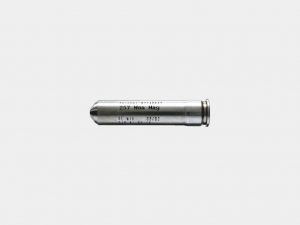 Diese Lehre prüft die Minimaltiefe des Patronenlagers in der Mitte der Schulter. Bei korrekter Lagertiefe muss sich, bei eingeführter minimaler Schulterlehre, der Verschluss der Waffe schließen lassen. Die Länge bis zur Schulter entspricht den Minimalmaßen.
Diese Lehre prüft die Minimaltiefe des Patronenlagers in der Mitte der Schulter. Bei korrekter Lagertiefe muss sich, bei eingeführter minimaler Schulterlehre, der Verschluss der Waffe schließen lassen. Die Länge bis zur Schulter entspricht den Minimalmaßen.
Da alle Weatherby-Patronen einen Gürtel haben, wird der Verschlussabstand am Gürtel gemessen. Die besondere Form der Lehre ergibt sich aus den großen Radien, die bei allen Weatherby-Patronen typisch sind. Die Lehre wird nur in Minimalausführung gefertigt.
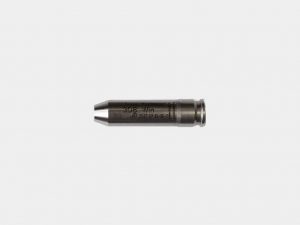 Für eine ganze Reihe von Patronen mit US-Ursprung liegen die maximalen Längenmaße der Patrone über den minimalen Längenmaßen des Patronenlagers. Besonders bei Kipplaufwaffen, die in den USA nur wenig Verbreitung haben, kommt es in diesen Kalibern dazu, dass sich der Verschluss der Waffe nicht schließen lässt, obwohl Patrone und Lager den vorgeschriebenen Maßen entsprechen.
Für eine ganze Reihe von Patronen mit US-Ursprung liegen die maximalen Längenmaße der Patrone über den minimalen Längenmaßen des Patronenlagers. Besonders bei Kipplaufwaffen, die in den USA nur wenig Verbreitung haben, kommt es in diesen Kalibern dazu, dass sich der Verschluss der Waffe nicht schließen lässt, obwohl Patrone und Lager den vorgeschriebenen Maßen entsprechen.
Um dieses Problem zu lösen, wurden von der CIP diese Abmaße „Delta“ der Länge der Patronenlager zugerechnet. Die Patronenlager können also um diese Differenz länger gefertigt werden. Um diese Maße zu prüfen, gibt es die „Delta“-Lehren, die um diese Differenz länger gefertigt sind. Diese Lehre prüft die Minimaltiefe L1 und L2 + „Delta“ und damit die Lage der Schulter Bei korrekter Lagertiefe muss sich, bei eingeführter minimaler Schulterlehre, der Verschluss der Waffe schließen lassen.
Randlehren für Büchsenpatronenlager
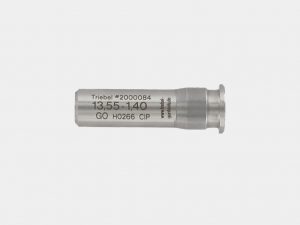 Diese Lehren prüfen die Mindesttiefe bzw. die Maximaltiefe der Randausfräsung von Büchsenpatronenlagern. Die Kontrolle der Randtiefe ist wichtig für die Verschlussabstandstoleranz.
Diese Lehren prüfen die Mindesttiefe bzw. die Maximaltiefe der Randausfräsung von Büchsenpatronenlagern. Die Kontrolle der Randtiefe ist wichtig für die Verschlussabstandstoleranz.
Bei korrekter Randtiefe muss sich der Verschluss der Waffe mit eingeführter Randlehre minimal schließen lassen, bei Benutzung der maximalen Randlehre darf sich der Verschluss nicht mehr schließen lassen. Die Lehre wird in Minimal- und Maximalausführung gefertigt. Sie werden immer paarweise verwendet.
Hülsenhalslehre minimal für Büchsenpatronenlage
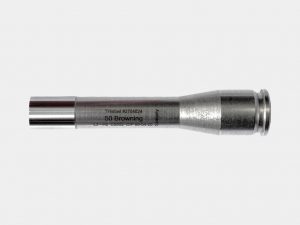 Diese Lehre prüft die Minimaltiefe des Hülsenhalses L3 und den Durchmesser H2. Bei korrekter Tiefe / korrektem Durchmesser muss sich bei eingeführter Lehre der Verschluss der Waffe schließen lassen. Die Länge L3 und der Durchmesser H2 entsprechen den Minimalmaßen. Die Lehre wird nur in Minimalausführung gefertigt. Diese Lehre wird erst eingesetzt, wenn der Verschlussabstand bereits geprüft und korrekt ist.
Diese Lehre prüft die Minimaltiefe des Hülsenhalses L3 und den Durchmesser H2. Bei korrekter Tiefe / korrektem Durchmesser muss sich bei eingeführter Lehre der Verschluss der Waffe schließen lassen. Die Länge L3 und der Durchmesser H2 entsprechen den Minimalmaßen. Die Lehre wird nur in Minimalausführung gefertigt. Diese Lehre wird erst eingesetzt, wenn der Verschlussabstand bereits geprüft und korrekt ist.
Die Prüfung dient nur zur Kontrolle des Mindestdurchmessers und der Mindesttiefe des Hülsenhalses. Sollte die Lehre klemmen, so ist der Durchmesser des Hülsenhalsbereiches zu klein. In der Regel wird die Lehre bei Schulterpatronen tiefer in das Patronenlager hineingehen als bis zur Bündigkeit, weil der Hülsenhals an Reibahlen meist ein kleines Übermaß in der Länge hat. Das dient der Sicherheit und der Kompensation der Abnutzung, die hier am höchsten ist. Durch die meist vorhandene Schrägung am Hülsenmund ergibt sich bei Übermaß im Durchmesser eine weitere Zunahme der Länge. Ein zu kurzer Hülsenhals kann das Geschoß einklemmen und zu erhöhtem Gasdruck führen.
Gürtellehren für Büchsenpatronenlager
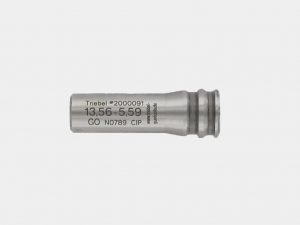 Diese Lehre prüft die Minimaltiefe E und damit die Tiefe der Gürtelausfräsung. Bei korrekter Lagertiefe muss sich, bei eingeführter minimaler Gürtellehre, der Verschluss der Waffe schließen lassen. Die Tiefe der Gürtelausfräsung entspricht den Minimalmaßen.
Diese Lehre prüft die Minimaltiefe E und damit die Tiefe der Gürtelausfräsung. Bei korrekter Lagertiefe muss sich, bei eingeführter minimaler Gürtellehre, der Verschluss der Waffe schließen lassen. Die Tiefe der Gürtelausfräsung entspricht den Minimalmaßen.
Wenn eine Patrone einen Gürtel hat, ist die Gürtellehre die Verschlussabstandslehre. Die Lehre wird in Minimalausführung und Maximalausführung gefertigt. Sie werden immer paarweise verwendet.
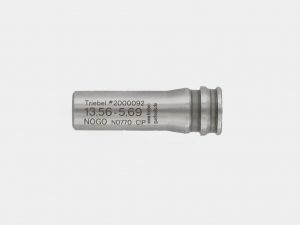 Diese Lehre prüft die Maximaltiefe E und damit die Tiefe der Gürtelausfräsung. Bei korrekter Lagertiefe darf sich, bei eingeführter maximaler Gürtellehre, der Verschluss der Waffe nicht schließen lassen. Die Tiefe der Gürtelausfräsung entspricht den Maximalmaßen.
Diese Lehre prüft die Maximaltiefe E und damit die Tiefe der Gürtelausfräsung. Bei korrekter Lagertiefe darf sich, bei eingeführter maximaler Gürtellehre, der Verschluss der Waffe nicht schließen lassen. Die Tiefe der Gürtelausfräsung entspricht den Maximalmaßen.
Wenn eine Patrone einen Gürtel hat, ist die Gürtellehre die Verschlussabstandslehre. Die Lehre wird in Minimalausführung und Maximalausführung gefertigt. Sie werden immer paarweise verwendet.
Übergangslehren für Büchsenpatronenlager
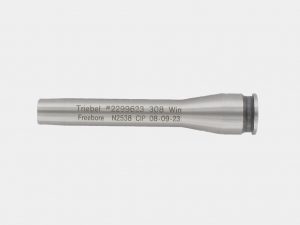
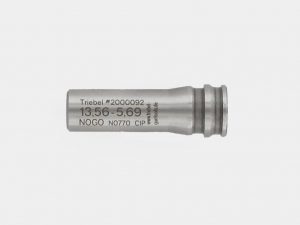 Diese Lehre prüft die Minimaltiefe E und damit die Tiefe der Gürtelausfräsung. Bei korrekter Lagertiefe muss sich, bei eingeführter minimaler Gürtellehre, der Verschluss der Waffe schließen lassen. Die Tiefe der Gürtelausfräsung entspricht den Minimalmaßen.
Diese Lehre prüft die Minimaltiefe E und damit die Tiefe der Gürtelausfräsung. Bei korrekter Lagertiefe muss sich, bei eingeführter minimaler Gürtellehre, der Verschluss der Waffe schließen lassen. Die Tiefe der Gürtelausfräsung entspricht den Minimalmaßen.
Wenn eine Patrone einen Gürtel hat, ist die Gürtellehre die Verschlussabstandslehre. Die Lehre wird in Minimalausführung und Maximalausführung gefertigt. Sie werden immer paarweise verwendet.
Pulverraumlehre für Büchsenpatronenlager
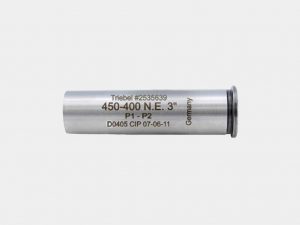 Diese Lehre prüft die Durchmesser P1 und P2‘ des Patronenlagers. Die Durchmesser entsprechen den Minimalmaßen des Patronenlagers. Die Lehre wird nur in Minimalausführung gefertigt. Die Pulverraumlehren für Patronenlager randloser Patronen haben eine Auszieherrille, die Lehren für die Patronenlager von Randpatronen sind mit einem Rand versehen.
Diese Lehre prüft die Durchmesser P1 und P2‘ des Patronenlagers. Die Durchmesser entsprechen den Minimalmaßen des Patronenlagers. Die Lehre wird nur in Minimalausführung gefertigt. Die Pulverraumlehren für Patronenlager randloser Patronen haben eine Auszieherrille, die Lehren für die Patronenlager von Randpatronen sind mit einem Rand versehen.
Da dieser Rand dünner ist, als bei den Patronenhülsen, ist er sehr empfindlich! Um bei Kipplaufwaffen ein Ausbrechen zu vermeiden, kann die Lehre an einer Stelle abgeschrägt werden. (Option) Aufgrund der sehr kleinen Winkel darf die Pulverraumlehre nicht mit Gewalt in das Patronenlager gedrückt werden. Die Lehre würde festklemmen. Sie muss dann, um ein Abbrechen des Lehrenrandes oder eine Beschädigung des Ausziehers zu vermeiden, mit einem Putzstock vorsichtig herausgestoßen werden.
Lehren für Schrotpatronenlager
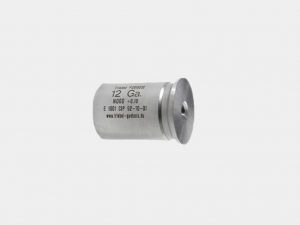 Diese Lehren prüfen die Mindesttiefe bzw. die Maximaltiefe der Randausfräsung von Schrotpatronenlagern. Die Kontrolle der Randtiefe ist wichtig für die Verschlussabstandstoleranz, die bei Kipplaufwaffen 0,20mm und bei Selbstladewaffen 0,35mm beträgt.
Diese Lehren prüfen die Mindesttiefe bzw. die Maximaltiefe der Randausfräsung von Schrotpatronenlagern. Die Kontrolle der Randtiefe ist wichtig für die Verschlussabstandstoleranz, die bei Kipplaufwaffen 0,20mm und bei Selbstladewaffen 0,35mm beträgt.
Bei korrekter Randtiefe muss sich der Verschluss der Waffe mit eingeführter Randlehre minimal schließen lassen, bei Benutzung der maximalen Randlehre darf sich der Verschluss nicht mehr schließen lassen. Die Lehre wird in Minimal- und Maximalausführung gefertigt. Sie werden immer paarweise verwendet.
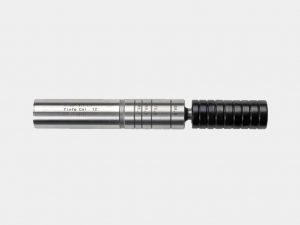 Diese Lehre prüft die Mindesttiefe von Schrotpatronenlagern.
Diese Lehre prüft die Mindesttiefe von Schrotpatronenlagern.
Bei korrekter Lagertiefe muss sich die Tiefenlehrelehre mindestens bis zu der entsprechenden Markierung einführen lassen. Die Lehre wird in Minimalausführung und Maximalausführung gefertigt.
Der Durchmesser wie auch die Längen entsprechen den Minimalmaßen. Die Lehre zeigt die Mindesttiefe für alle Längen des jeweiligen Kalibers.
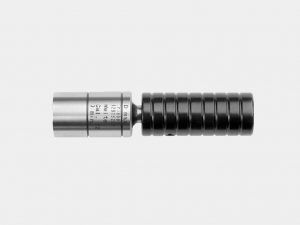 Diese Lehre prüft die Maximaltiefe L am minimalen Bezugsdurchmesser H von Schrotpatronenlagern. Bei korrekter Lagertiefe darf sich die Tiefenlehrelehre höchstens bis zu der entsprechenden Markierung einführen lassen. Die Längen entsprechen den Maximalmaßen laut CIP. Der Durchmesser H entspricht dem Minimalmass laut CIP. Dadurch, dass der Durchmesser H bei der minimalen als auch der maximalen Tiefenlehre jeweils dem gleichen Maß entspricht, ist ein Vergleich der Tiefe (Lagerlänge) möglich. Würde der Durchmesser H bei der maximalen Tiefenlehre ebenfalls den maximal-Werten entsprechen, würde sich logischerweise der Bezugspunkt als Anlagefläche für die Lehre verschieben. Daher wären die gepürften Längenwerte nicht mehr mit den Werten der minimalen Lehre vergleichbar. Die Lehre zeigt die Höchsttiefe L für alle Längen des jeweiligen Kalibers bei minimalem Durchmesser H.
Diese Lehre prüft die Maximaltiefe L am minimalen Bezugsdurchmesser H von Schrotpatronenlagern. Bei korrekter Lagertiefe darf sich die Tiefenlehrelehre höchstens bis zu der entsprechenden Markierung einführen lassen. Die Längen entsprechen den Maximalmaßen laut CIP. Der Durchmesser H entspricht dem Minimalmass laut CIP. Dadurch, dass der Durchmesser H bei der minimalen als auch der maximalen Tiefenlehre jeweils dem gleichen Maß entspricht, ist ein Vergleich der Tiefe (Lagerlänge) möglich. Würde der Durchmesser H bei der maximalen Tiefenlehre ebenfalls den maximal-Werten entsprechen, würde sich logischerweise der Bezugspunkt als Anlagefläche für die Lehre verschieben. Daher wären die gepürften Längenwerte nicht mehr mit den Werten der minimalen Lehre vergleichbar. Die Lehre zeigt die Höchsttiefe L für alle Längen des jeweiligen Kalibers bei minimalem Durchmesser H.
Lehren für Pistolenpatronenlager
Schulterlehren für Pistolenpatronenlager
Diese Lehre prüft die Minimaltiefe L1 und L2 und damit die Lage der Schulter. Bei korrekter Lagertiefe muss sich bei eingeführter minimaler Schulterlehre der Verschluss der Waffe schließen lassen. Die Lage der Schulter entspricht den Minimalmaßen. Die Lehre wird in Minimalausführung und Maximalausführung gefertigt. Sie werden immer paarweise verwendet. Optional sind Lehrensätze mit Abstufung von z.B. 0,02mm erhältlich, um den Verschlussabstand genau feststellen zu können.
Diese Lehre prüft die Maximaltiefe L1 und L2 und damit die Lage der Schulter Bei korrekter Lagertiefe darf sich, bei eingeführter maximaler Schulterlehre, der Verschluss der Waffe nicht schließen lassen. Die Lage der Schulter entspricht den Maximalmaßen. Die Lehre wird in Minimalausführung und Maximalausführung gefertigt. Sie werden immer paarweise verwendet. Optional sind Lehrensätze mit Abstufung von z.B. 0,02mm erhältlich, um den Verschlussabstand genau feststellen zu können.
Randlehren für Pistolenpatronenlager
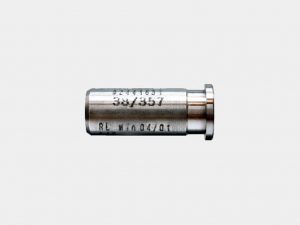 Diese Lehren prüfen die Mindesttiefe bzw. die Maximaltiefe der Randausfräsung von Pistolenpatronenlagern. Die Kontrolle der Randtiefe ist wichtig für die Verschlussabstandstoleranz.
Diese Lehren prüfen die Mindesttiefe bzw. die Maximaltiefe der Randausfräsung von Pistolenpatronenlagern. Die Kontrolle der Randtiefe ist wichtig für die Verschlussabstandstoleranz.
Bei korrekter Randtiefe muss sich der Verschluss der Waffe mit eingeführter Randlehre minimal schließen lassen, bei Benutzung der maximalen Randlehre darf sich der Verschluss nicht mehr schließen lassen. Die Lehre wird in Minimal- und Maximalausführung gefertigt. Sie werden immer paarweise verwendet.
Hülsenmundlehren für Pistolenpatronenlager
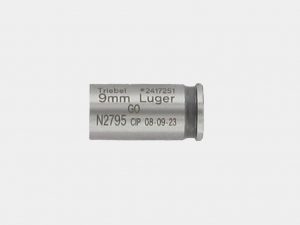 Diese Lehre prüft die Minimaltiefe L3 des Patronenlagers. Bei korrekter Lagertiefe muss sich bei eingeführter minimaler Verschlussabstandslehre der Verschluss der Waffe schließen lassen. Die Länge der Patronenlagerlehre entspricht den Minimalmaßen. Wenn die Patrone weder Rand noch Schulter hat, ist die L3-Lehre die Verschlussabstandslehre. Die Lehren werden in Minimalausführung und Maximalausführung gefertigt. Sie werden immer paarweise verwendet.
Diese Lehre prüft die Minimaltiefe L3 des Patronenlagers. Bei korrekter Lagertiefe muss sich bei eingeführter minimaler Verschlussabstandslehre der Verschluss der Waffe schließen lassen. Die Länge der Patronenlagerlehre entspricht den Minimalmaßen. Wenn die Patrone weder Rand noch Schulter hat, ist die L3-Lehre die Verschlussabstandslehre. Die Lehren werden in Minimalausführung und Maximalausführung gefertigt. Sie werden immer paarweise verwendet.
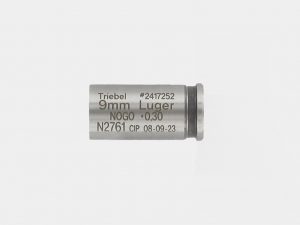 Diese Lehre prüft die Maximaltiefe L3 des Patronenlagers. Bei korrekter Lagertiefe darf sich bei eingeführter maximaler Verschlussabstandslehre der Verschluss der Waffe nicht schließen lassen.
Diese Lehre prüft die Maximaltiefe L3 des Patronenlagers. Bei korrekter Lagertiefe darf sich bei eingeführter maximaler Verschlussabstandslehre der Verschluss der Waffe nicht schließen lassen.
Die Länge der Patronenlagerlehre entspricht den Maximalmaßen. Wenn die Patrone weder Rand noch Schulter hat, ist die L3-Lehre die Verschlussabstandslehre. Die Lehren werden in Minimalausführung und Maximalausführung gefertigt. Sie werden immer paarweise verwendet.
Übergangslehren für Pistolenpatronenlager
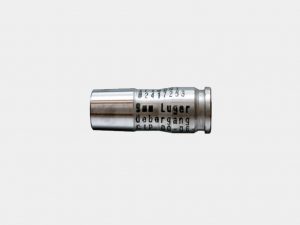 Diese Lehre prüft die Minimaltiefe des Übergangkegels Bei korrekter Tiefe muss sich bei eingeführter Lehre der Verschluss der Waffe schließen lassen. Die Abmessung der Lehre entspricht den Minimalmaßen. Die Lehre wird standardmäßig in Minimalausführung gefertigt.
Diese Lehre prüft die Minimaltiefe des Übergangkegels Bei korrekter Tiefe muss sich bei eingeführter Lehre der Verschluss der Waffe schließen lassen. Die Abmessung der Lehre entspricht den Minimalmaßen. Die Lehre wird standardmäßig in Minimalausführung gefertigt.
Es werden zwei grundsätzliche Übergangsarten unterschieden:
1. Nur Kegel
2. Kegel mit zylindrischem Teil
Bei Übergängen, die aus einem Kegel mit zylindrischem Teil bestehen, muss sichergestellt werden, dass die Lehre nicht im zylindrischen Teil klemmt. Eine Fehlmessung wäre die Folge. Aufgrund der sehr kleinen Winkel darf die Übergangslehre nicht mit Gewalt in das Patronenlager gedrückt werden. Die Lehre würde festklemmen. Sie muss dann, um ein Abbrechen des Lehrenrandes oder eine Beschädigung des Ausziehers zu vermeiden, mit einem Putzstock vorsichtig herausgestoßen werden.
Pulverraumlehren für Pistolenpatronenlager
Diese Lehre prüft die Durchmesser P1 und P2‘ des Patronenlagers. Die Durchmesser entsprechen den Minimalmaßen des Patronenlagers. Die Lehre wird nur in Minimalausführung gefertigt. Die Pulverraumlehren für Patronenlager randloser Patronen haben eine Auszieherrille, die Lehren für die Patronenlager von Randpatronen sind mit einem Rand versehen. Da dieser Rand dünner ist, als bei den Patronenhülsen, ist er sehr empfindlich!
Aufgrund der sehr kleinen Winkel darf die Pulverraumlehre nicht mit Gewalt in das Patronenlager gedrückt werden. Die Lehre würde festklemmen. Sie muss dann, um ein Abbrechen des Lehrenrandes oder eine Beschädigung des Ausziehers zu vermeiden, mit einem Putzstock vorsichtig herausgestoßen werden.

